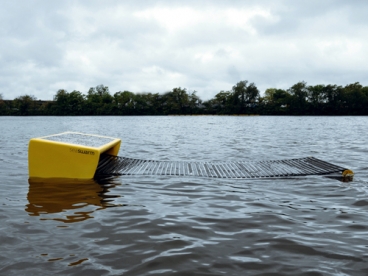 MIT researchers tested the first prototype of the Seaswarm, a pack of robots that use nanotechnology to suck up oil from the surface of the ocean for immediate processing.
MIT researchers tested the first prototype of the Seaswarm, a pack of robots that use nanotechnology to suck up oil from the surface of the ocean for immediate processing.
When completed, the robots will be able to travel along oil-spilled waters, collecting oil more cheaply and efficiently than oil skimmers. The robots are large: 16 feet in length and seven feet in width. They push a conveyor belt wrapped by an oil-absorbing nanowire mesh that repels water while slurping up to twenty times its weight in oil.
Once the robot is full, the material can be heated up to remove the oil and sent back into the waters to collect more. MIT’s SENSEable City Lab Associate Director Assaf Biderman likens it to a “rolling carpet” that could be able to clean for weeks on end in the right conditions. The robots are powered by solar panels and need only 100 watts of electricity to operate.
Seaswarm’s name refers to how a team of robots behave when they’re sent out on a mission together. The robots communicate wirelessly with one another and use GPS to sense where other robots in the fleet are working. This lets them spread evenly to clean the spill with more precision. The robots can also detect the edge of the spill and work their way inward.
This video explains how the robots clean up oil and collaborate with one other:
Researchers estimate that 5,000 robots could clean a spill as large as the one in the gulf in a month. The group plans to enter its developments to the X Prize competition for oil cleanup.
The prototype comes after months of development. Researchers planned to present Seaswarm at the TEDxOilSpill conference, but were apparently stopped last-minute due to an “unresolved intellectual property dispute at MIT.”
Another group of researchers at Texas Tech has been working on a similar oil-absorbing material we mentioned before as a solution to oil spill cleanup.
We can hope there will be no future oil spills, but in case there are, the Seaswarm could offer hope for a quicker cleanup.